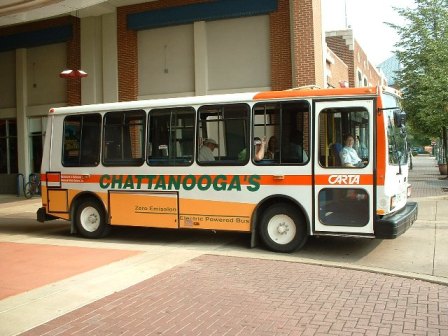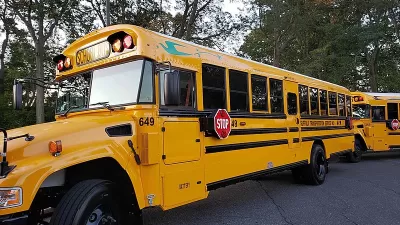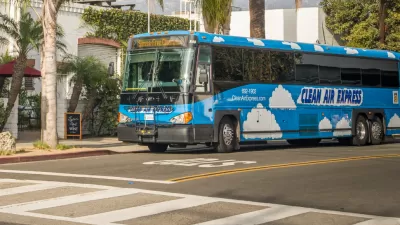Amid the stimulus-backed hullabaloo over high speed rail, perhaps efforts by municipalities to supplant old-school diesel with new era electric bus fleets have been overshadowed. Maybe it is still too soon, but there has been little media coverage on cities making the switch from diesel to hybrid or electric buses; however, with the money that is being pumped in, and the major shift in national perspective on the importance of sustainability, energy efficiency, and pollution reduction, now is the time to bypass the delays of a hybrid “stepping stone” and leap straight for all-electric transit systems.
Amid the stimulus-backed hullabaloo over high speed rail, perhaps efforts by municipalities to supplant old-school diesel with new era electric bus fleets have been overshadowed. Maybe it is still too soon, but there has been little media coverage on cities making the switch from diesel to hybrid or electric buses; however, with the money that is being pumped in, and the major shift in national perspective on the importance of sustainability, energy efficiency, and pollution reduction, now is the time to bypass the delays of a hybrid "stepping stone" and leap straight for all-electric transit systems.
There is a great passage in the science fiction story Earth by David Brin where he suggests that the American space shuttle was the most complicated machine ever built. From that point forward, he writes, engineers employed technology and software to minimize the number of parts, and therefore, the complexity of mechanical systems. Reduced number of parts allows for fewer raw materials, lower weight and hence lower power requirements. Most importantly, fewer parts results in increased reliability as the number of ways a system can fail (mechanically) decreases proportionally. You can already see this phenomenon in what is popularly referred to as "convergence", that is, multiple devices (i.e. cameras, mp3 players, cell phones, game players, etc.) converging into a single device that uses software to capitalize on common hardware components shared by several systems.
All this talk about "number of parts" is a lead-in to the idea that hybrid-electric technology is not, by any means, a categorical solution to the woes of internal combustion; rather, it is merely a "stepping stone" to get us from 100% fossil fuel to 100% electric locomotion. Between these two states, so-called hybrid vehicles are a combination of two parallel locomotion systems used to glean the air quality and energy efficiency benefits of all-electric systems while compensating for the limitations of current battery technology on range and support of onboard systems, such as climate control, with assistance from a smaller internal combustion engine. But with the need for two systems, hybrid vehicles increase in complexity, number of parts, and therefore, potential for failure (it's kind of like the even-bigger mess one must make in the process of cleaning one's room). Moreover, raw material requirements, emissions, reliance on fossil fuel, and noise associated with internal combustion are all present (albeit reduced) with hybrid vehicles. Indeed, it would be interesting to compare the carbon footprint on a hybrid vehicle to that of a standard fossil fuel vehicle for these reasons (but please let's not waste our time there!).
For personal cars, cutting edge all-electric technology is only now reaching acceptable range/charge-time stats. This is not so for buses, however. Many cities, such as Chattanooga, Santa Barbara, and Miami Beach, have been successfully operating all-electric bus systems for over ten years. Electric vehicle enthusiasts will passionately reaffirm the fact that electric bus systems operated just fine, even in large municipalities such as New York City, until the "limitless supply" of cheap fossil fuels in the early 20th Century made the internal combustion engine more attractive (and don't forget about the "Great American Streetcar Scandal"). When it comes to municipal bus fleets, particularly in smaller cities with shorter routes and lower ridership, the use of hybrid instead of all-electric bus technology is more than a bit puzzling. Existing all-electric bus system precedents and all the faults of hybrid systems listed above point to the conclusion that, in many cases, we are simply not using the right tool for the job.

In years past, an unmotivated (read: no cost incentive) move away from fossil fuels barely justified the gradual adaptation from internal combustion to all-electric in the form of a hybrid "stepping stone" technology across the spectrum of transport systems. But now that the spectre of soaring fuel costs are hurtling us towards sustainability in high gear, the need for this stepping stone is not universal and, in some cases, counter-effective. For municipal transit systems at least, a more careful implementation of the most appropriate technology will allow us to move faster towards sustainability and simpler, more efficient transit vehicles. The sooner we employ all-electric technology in applicable transit systems the sooner hybrid buses will seem as convoluted as the space shuttle.

Maui's Vacation Rental Debate Turns Ugly
Verbal attacks, misinformation campaigns and fistfights plague a high-stakes debate to convert thousands of vacation rentals into long-term housing.

Planetizen Federal Action Tracker
A weekly monitor of how Trump’s orders and actions are impacting planners and planning in America.

Chicago’s Ghost Rails
Just beneath the surface of the modern city lie the remnants of its expansive early 20th-century streetcar system.

Bend, Oregon Zoning Reforms Prioritize Small-Scale Housing
The city altered its zoning code to allow multi-family housing and eliminated parking mandates citywide.

Amtrak Cutting Jobs, Funding to High-Speed Rail
The agency plans to cut 10 percent of its workforce and has confirmed it will not fund new high-speed rail projects.

LA Denies Basic Services to Unhoused Residents
The city has repeatedly failed to respond to requests for trash pickup at encampment sites, and eliminated a program that provided mobile showers and toilets.
Urban Design for Planners 1: Software Tools
This six-course series explores essential urban design concepts using open source software and equips planners with the tools they need to participate fully in the urban design process.
Planning for Universal Design
Learn the tools for implementing Universal Design in planning regulations.
planning NEXT
Appalachian Highlands Housing Partners
Mpact (founded as Rail~Volution)
City of Camden Redevelopment Agency
City of Astoria
City of Portland
City of Laramie






























